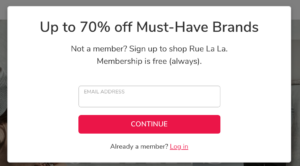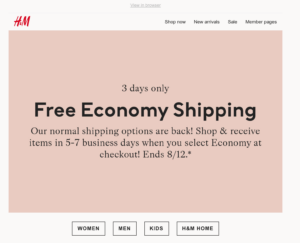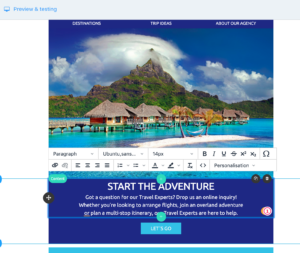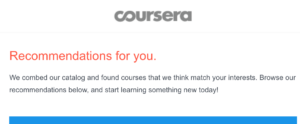Email copywriting tips to create content people want to read
Let’s make one thing clear right away: email copywriting could be a bit hard.
The fact that makes it hard is the abundant competition. With an average person receiving over a hundred emails every day, engaging them can be a challenge.
But hey, it’s not impossible. If done right, you can get those software signups, sales, leads, clicks, or whatever your marketing strategy needs.
Email copywriting plays a major role in making that happen. Here’s how to make your emails as engaging as possible with compelling, simple, and customer-focused copy.
Table of Contents
1. Remember about the purpose of the campaign
The fact that someone subscribed to your drip email marketing campaigns list doesn’t mean you can send them whatever you want. They’ve given the permission to get your emails because you promised them something.
What was it? A newsletter on industry news? Discount codes? Business tips?
This pop-up, for example, promises giving discounts up to 70 per cent off. So, the website visitor seeing this message has certain expectations when they sign up.

Breaking these promises by sending something else besides the content you promised is a terrible idea. It can quickly result in your emails being sent to the trash folder.
So, before you write anything, learn what the campaign is all about. It’ll help you set the right tone and make the copy more engaging for the reader.
2. Win people over with attention-grabbing subject line
The subject line is your best bet to get more emails opened and read. There’s no universal formula on creating one that works all the time, though, but there’s something that can help.
The most important thing here, according to professional essay writing service, is to think about the interests of the recipient. If you appeal to something they’re interested in, you have a good chance to win them over (convince them to open your email, that is).
Here are some real subject line examples based on campaign goals.
- Discounts: “Final Week to Score 40% Off” – Under Armour
- Promotional offers: “Get Wired for less than $1 a month” – Wired Magazine
- Newsletter with professional knowledge: “Comprehensive SEO guide to event schema markup” – Search Engine Watch
So, the trick is to make the subject line focused on the benefits for the recipient to entice them to click on it. As the examples show, you can show the value of your emails with numbers and benefits.
3. Keep the email text as concise as possible
A wall of text.
That’s the last thing your recipients want to see when they open an email. The temptation to give them a lot of information might be really strong, but you need to focus on essential information only.
Let’s exercise.
Suppose you need to write a B2C newsletter email.
There, you need to let customers know that your brand is offering free shipping. To get it, customers need to choose a specific shipping method (“Free”) on the online checkout. The offer doesn’t mean that the delivery will actually be faster. But it’ll be free.
How would you write this message? Would you try to entice the customers with a quick tease that free shipping is something they’ve been waiting for? Or maybe something else?
Take a look at this email from H&M to see how the brand tackled this challenge.
The email’s subject line says, “Free shipping! Let’s do this,” which suggests the purpose of informing the customers about the opportunity to get free shipping. Quick and clear.
The main text is just as good. No fluff, no marketing talk, just the details of the offer.

That’s how you need to try to make your emails, too. The concise text means that you leave non-critical details out while focusing on the main value for the recipient.
One great way to keep your text concise is to type in a free email template editor. By doing so, you get an instant preview of the text, which helps to see if you’re overdoing it.
Besides, the email templates come with pre-written text on them, the length of which was optimized to look great on that specific template. Take a look.

So, the length of your email text will depend, but keeping it concise is your best bet.
Important! Proofread every email copy carefully with tools like SupremeDissertations or TopEssayWriting. Having a silly mistake like a typo can quickly ruin a good first impression and make the recipient want to unsubscribe.
4. Make it personal
I mean that in a good way, of course. You can do so by using words like “you” and “your.” They make the email sounds like a conversation between your customer and you, which has a powerful effect.
This style of writing:
- makes it easier to read the message
- allows you to guide the reader, which enables to position yourself as an expert
- makes the text feel authentic, like a message from someone you know.
See how Coursera uses this style in this newsletter email.

To make it work, use natural, conversational language. Here are tips for mastering this style:
- Write your draft and try to shorten each sentence by half
- Use simple words you’d use to talk to a friend
- Make short paragraphs of no more than two sentences
- Avoid passive voice. It makes the text sound like it was written by a robot.
Write and test
These four tips give you a great start to write nice, engaging emails for your business. But remember that no single way works best to make email opened and read, so the best way to go about email marketing is to try different text versions.
Have at least two copies ready for each email and test how recipients engage with them. This will allow you to understand the writing techniques your customer react to more. Ultimately, you’ll be able to write in a unique, engaging style.
Continue Reading: 6 ridiculously awesome email copywriting tips that convert
About the Author
Erica Sunarjo is a professional writer and editor with a Master’s degree in Marketing and Social Media. She writes thought-provoking articles for publications in a variety of media. She is a regular contributor writer at GrabMyEssay. Even though she is an expert in numerous fields of business, Erica is always dedicated to learning new things. She actively visits conferences and takes online classes to keep her mind open to innovative ideas.

 Tips-copywritercollective
Tips-copywritercollective Brands-copywritercollective
Brands-copywritercollective
 Translators-copywritercollective
Translators-copywritercollective